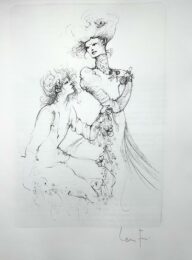


1907-1996
Perhaps the most fiercely and gloriously independent woman artist of the 20th century was the iconoclastic Leonor Fini. Fini herself never identified as a surrealist and never embraced the term “woman artist.” She detested the misogynistic beliefs of the movement’s leader André Breton and never gave up her freedom to him. Nevertheless, from 1936 until the present, almost all significant Surrealist exhibitions have featured her works.
In 1907, Fini was born in Argentina. Her mother kidnapped her and took her to Trieste, where she was born. When Fini fled the house for the first seven years of her life, she pretended to be a male in order to thwart her father’s attempts to capture her. She was raised by witty and creative women, and it didn’t take her long to determine she wanted to be an artist. She was already close to Giorgio de Chirico and his circle by the time she moved to Paris in 1931. When she arrived in Paris, Max Ernst and the Surrealists who were around him instantly “adopted” her. Not only as an artist but also as a person, Fini rose to fame. She cultivated a persona of drama, mystery, and intrigue by living life like an actor in a play.
A remarkable inventory of the thinkers and artists of the 20th century can be found in the list of people she knew, worked with, or was influenced by over the ensuing decades: Jean Cocteau, Man Ray, Leonora Carrington, Salvador Dali, Joseph Cornell, Dora Maar, Anna Magnani, Albert Camus, Jean Genet, Federico Fellini, John Huston, and Georges Bataille, to name a few.
Fini eventually began incorporating a variety of research methods within her work. These were inquiries into age and beauty, the true nature of love and sex, the mysterious silence that eludes individuals who want to communicate, and the shadowy figures who rise from murky seas and mottled landscapes. Over the course of a seven-decade career, only few artists could be as equally open and elusive.